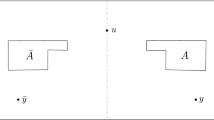Abstract
We derive rigorously general results on the critical behavior of the magnetization in Ising models, as a function of the temperature and the external field. For the nearest-neighbor models it is shown that ind⩾4 dimensions the magnetization is continuous atT c and its critical exponents take the classical valuesδ=3 andβ=1/2, with possible logarithmic corrections atd=4. The continuity, and other explicit bounds, formally extend tod>3 1/2. Other systems to which the results apply include long-range models ind=1 dimension, with 1/|x−y|λ couplings, for which 2/(λ−1) replacesd in the above summary. The results are obtained by means of differential inequalities derived here using the random current representation, which is discussed in detail for the case of a nonvanishing magnetic field.
Similar content being viewed by others
References
A. D. Sokal, A rigorous inequality for the specific heat of an Ising orφ 4 ferromagnet.Phys. Lett. 71A:451–453 (1979).
M. Aizenman, Geometric analysis ofφ 24 fields and Ising models. Parts I and II,Commun. Math. Phys. 86:1–48 (1982).
M. Aizenman and R. Graham, On the renormalized coupling constant and the susceptibility inφ 44 field theory and the Ising model in four dimensions,Nucl. Phys. B225[FS9]:261–288 (1983).
J. Fröhlich, On the triviality ofλφ 2d theories and the approach to the critical point ind > 4 dimension,Nucl. Phys. B200[FS4]:281–296 (1982).
S. Coleman and E. Weinberg, Radiative correction as the origin of spontaneous symmetry breakdown,Phys. Rev. D7:1888 (1973).
M. Aizenman, Rigorous studies of critical behavior. II,Statistical Physics and Dynamical Systems: Rigorous Results (Birkhäuser, Boston, 1986, to be published).
J. Fröhlich and A. D. Sokal, to be published.
C. Newman. private communication.
J. Fröhlich, B. Simon, and T. Spencer, Infrared bounds, phase transition and continuous symmetry breaking,Commun. Math. Phys. 50:79–85 (1976).
A. D. Sokal, An alternate constructive approach to theφ 43 quantum field theory, and a possible destructive approach toφ 44 ,Annal. Inst. Henri Poincaré 37:317–398 (1982).
M. Aizenman, Rigorous studies of critical behavior,Applications of Field Theory in Statistical Mechanics, L. Garrido, ed., Springer Lecture Notes in Physics (SpringerVerlag, New York, in press).
D. Brydges, J. Fröhlich, and T. Spencer, The random walk representation of classical spin systems and correlation inequalities,Commun. Math. Phys. 83:123–150 (1982).
D. C. Brydges, J. Fröhlich, and A. D. Sokal, The random walk representation of classical spin systems and correlation inequalities. II. The skeleton inequalities,Commun. Math. Phys. 91:117–139 (1983).
R. Fernández, J. Fröhlich, and A. D. Sokal, in preparation.
A. D. Sokal, More inequalities for critical exponents,J. Stat. Phys. 25:25–56 (1981).
R. B. Griffiths, C. A. Hurst, and S. Sherman, Concavity of magnetization of an Ising ferromagnet in a positive external field,J. Math. Phys. 11:790 (1970).
E. Brezin, J. C. Le Guillou, and J. Zinn-Justin, inPhase Transitions and Critical Phenomena, C. Domb and M. S. Green, eds. (Academic Press, London, New York, San Francisco, 1976).
J. Lebowitz, private communication.
R. B. Griffiths, Correlations in Ising ferromagnets. II. External magnetic fields,J. Math. Phys. 8:484–489 (1967).
M. E. Fisher, Critical temperatures of anisotropic Ising lattices. II. General upper bounds,Phys. Rev. 162:480–485 (1967).
R. Graham, Correlation inequalities for the truncated two-point function of an Ising ferromagnet,J. Stat. Phys. 29:177–183 (1982).
A. D. Sokal, private communication; see G. Felder and J. Fröhlich, Intersection properties of simple random walks: A renormalization group approach,Commun. Math. Phys. 97:111–124 (1985).
J. Fröhlich, R. Israel, E. H. Lieb, and B. Simon, Phase transitions and reflection positivity. I. General theory and long-range lattice models,Commun. Math. Phys. 62:1 (1978).
B. Simon and R. B. Griffiths, The (φ 4)2 field theory as a classical Ising model,Commun. Math. Phys. 33:145–164 (1973).
Author information
Authors and Affiliations
Additional information
Research supported in part by NSF grant PHY-8301493 A02, and by a John S. Guggenheim Foundation fellowship (M.A.).
Rights and permissions
About this article
Cite this article
Aizenman, M., Fernández, R. On the critical behavior of the magnetization in high-dimensional Ising models. J Stat Phys 44, 393–454 (1986). https://doi.org/10.1007/BF01011304
Received:
Revised:
Issue Date:
DOI: https://doi.org/10.1007/BF01011304



